
Houston is the energy capital of the world and home to one of the world’s best medical centers. The University of Houston, as the city’s academic research leader, is vital to the future of medicine, energy, and high technology, to name just a few.
UH scientists and engineers collaborate with Texas Medical Center researchers on dozens of projects with a single goal —improving healthcare. Our programs and facilities are expanding in the Texas Medical Center, from Pharmacy to a new Health MBA UH researchers also team with the world’s leading energy producers to streamline conventional energy production and to find newer, cleaner energy.
The university’s remarkable contributions to research-funded primarily by $77.5 million in grants for FY2006-take place in the Research and Academic Core of campus. Last year, construction was completed on two campus landmarks-the Science and Engineering Research and Classroom Complex (SERCC) and the renovated and expanded M.D. Anderson Library including The Honors College. This year, UH received state funding to renovate several research buildings including Science and Research 1 and the Lamar Fleming Building. |
|
|
Biochip-based DNA synthesis lands “top woman” award for Gao
Houstonians can find one of our own on the city’s list of top women in technology. For three consecutive years, UH professors have received Houston Leadership in Technology Awards from the city’s chapter of the Association for Women in Computing. This year was no different. Xiaolian Gao, professor of biology and biochemistry, received the honor for her research in miniaturizing synthesis of multiple genes. Gao’s work has established the university as a leader in synthetic biology, an emerging life science field that’s key to the future of healthcare. Her results were published in the science journal Nature, yielding interviews with The New York Times and Newsweek. |
Engineers make medical history with diabetes find
It’s one step in history and a giant step for diabetes. Today, the disease affects nearly 21 million Americans or 7 percent of the population. Peter Vekilov, associate professor of chemical and biomolecular engineering, has found a new mechanism for the formation of insulin crystals in the pancreas. Since insufficient insulin production in the pancreas is one of the manifestations of adult-onset diabetes, the study takes a look at the process of how insulin is produced. Understanding how the body creates this hormone will make it easier for researchers to discover why some individuals don’t produce enough insulin and thus develop diabetes.
Peter Vekilov, associate professor of chemical and biomolecular engineering, and Dimitra Georgiou, a recent doctoral graduate in chemical engineering, work with an atomic-force microscope to capture images of insulin molecules only five nanometers in diameter. |
|
SeeingYourBrain AtWork
Computer scientists receive $900K NSF grant to study brain function and human learning
A $900,000 National Science Foundation (NSF) grant—the largest instrumentation grant ever awarded to UH by NSF—will foster collaboration between computer science and medicine and develop technologies that may help in the noninvasive diagnosis and treatment of a variety of diseases.
With a primary focus of merging noninvasive imaging technologies with computational resources, the grant seeks to extend knowledge of how humans learn, study brain function and behavior, detect cognitive impairment, provide continuous noninvasive monitoring of human physiology, analyze facial expressions, and improve biometrics-based security.
Each scientist in the group brings a different area of expertise and a separate laboratory—the grant will unify these labs, extend the range of each technology, and add computation and visualization resources. |
FIVE-STAR TEAM
Marc Garbey, professor and department chair, focuses on tissue remodeling with applications involving vein graft failure and neurovascular diseases.
Ioannis Kakadiaris, founder and director of the Computational Biomedicine Lab, developed technology with the potential to alert physicians to heart attack risk through early detection of blood vessel regions prone to future rupture and blockage.
Ioannis Pavlidis’ Computational Physiology Lab developed ATHEMOS (Automatic THErmal MOnitoring System) to perform touchless physiological monitoring of its user’s health.
Ricardo Vilalta, co-director of the Data Mining and Machine Learning Group, uses the group’s expertise in planetary science and particle physics to analyze biomedical data sets stemming from multiple sensors.
George Zouridakis, NSF grant principal investigator and director of the Biomedical Imaging Lab, specializes in structural and functional imaging and the analysis of the electrical, magnetic, and infrared aspects of brain activity to better understand brain function and behavior.
|
Biologist works to make HIV, Ebola vaccines a reality
Gene-specific medicine may be on its way. Purifying DNA and RNA is key to diagnosing genetic diseases, genome sequencing, and the potential manufacture of DNA-based vaccines for HIV and for
diseases like Ebola. George E. Fox, professor
of biology and biochemistry and professor
of chemical engineering, is studying RNA—
the template for the translation of genes into
proteins. With recent discoveries of RNA’s role in regulating gene expression in mammalian cells, Fox’s ability to design novel RNA is
expected to facilitate new therapies for a
variety of human ailments. |
Pharmacist explores user-friendly patch chemotherapy
It worked for smoking cessation and birth control, and now perhaps for chemotherapy.
Diana Chow, associate professor of pharmaceutics, is exploring the potential of a transdermal drug delivery system—known as the patch—as a user-friendly way to administer noninvasive chemotherapy for cancer patients. Such patches are painless, convenient, and easy to use—encouraging greater patient compliance while reducing nausea and other adverse effects. Additional benefits would include fewer clinic or hospital visits, as well as providing greater efficacy through controlled release that would eliminate the “spikes” that occur when drugs are delivered intravenously or orally.
Computer scientists receive $900K NSF grant to study brain function and human learning
Study gauges effects of peer pressure on obesity
Rebecca Lee wants to know if there really is strength in numbers. Funded with a $3 million grant from the National Institutes of Health, the STAR (Striving Together Achieving Results) and HIP (Health Is Power) projects examine whether belonging to a small team can have a positive influence on exercising and eating right. Lee, assistant professor of health and human performance, says group strategies, like Weight Watchers, are helping people meet individual goals. Her study is designed to examine a group of women with a shared goal. Such groups usually have stronger outcomes and better maintenance than those that focus on individual goals. |
Unique study looks to penguins for improved human mobility
Penguins may help the elderly get on their feet again. Dozens of teeter-tottering king penguins at Galveston’s Moody Gardens are the subjects of a research project investigating balance and locomotion for people with mobility impairments. Max Kurz, assistant professor of health and human performance, is hoping to translate the penguins’ excessive side-to-side motion into a level of stability resulting in a mobile human patient. “Penguins may look clumsy on land, but they are very efficient walkers,” says Kurz. “Nature has already done many of the experiments for us.” Next up for Kurz—elephants and alligators. |
|
Visionary center to combat MS opens at UH
UH is joining the fifty-year fight against multiple sclerosis in a big way.
The UH College of Optometry’s University Eye Institute and the National Multiple Sclerosis Society have formed a first-of-its-kind alliance—the result is a UH-based clinic to evaluate the sight of adult and pediatric MS patients. MS Eye CARE (Multiple Sclerosis Eye Center for Analysis, Research and Education), a formal affiliate of the National MS Society, focuses on recognizing and studying the very early visual and eye movement findings relating to MS. The center is especially important for eyecare professionals, who are often the first healthcare providers to see MS patients. Almost half of all MS cases show initial symptoms in the eyes.
With the chances of the early signs being easily overlooked, MS Eye CARE is setting out to aid healthcare professionals in early diagnosis of the disease by blending clinical care, electrophysical care, electrodiagnostic testing, and new imaging technologies. The center also works with collaborating medical facilities including the Maxine Mesinger MS Center, The University of Texas Health Science Center at Houston’s MS group, Texas Children’s Hospital, and a host of neurologists caring for MS patients. |
UH, Methodist team to map last frontier of medicine
The human brain is often considered to be the last frontier in modern medicine. Now, academia and medicine are joining forces to explore, understand, and cure many of the disorders affecting the brain and nervous system. A collaboration between UH researchers and The Methodist Neurological Institute engages engineers, physicists, mathematicians, and other university academicians in close partnership with clinical scientists at The Methodist Hospital. UH researchers are developing new techniques for brain and neuron imaging, determining which brain mechanisms control vision and language, and learning how brain function changes as a result of experience. They also are researching treatments for Alzheimer’s, Parkinson’s, and brain aneurysms, including the study of embryonic brain development and spinal cord diseases. |
Pharmacy researchers seek to lessen effects of weak immune systems
Capitalizing on its long-running relationships with Texas Medical Center institutions, the College of Pharmacy is carving out a niche in the early study and treatment of infectious diseases. The research delves into patients at high risk for infection due to weakened immune systems, particularly those undergoing chemotherapy or suffering from AIDS/HIV. Researchers also are examining how antibiotic dosing can be optimized to suppress resistance, developing new tools to understand how drug resistance spreads, and studying pathogens that afflict severely immuno-compromised patients with cancer. |
UH receives $1.5M grant to study drug abuse among Katrina evacuees
Hurricane Katrina leveled cities, uprooted people, and changed lives—leaving an estimated 150,000 people to call Houston home. The National Institute on Drug Abuse awarded a three-year, $1.5 million grant to UH’s Office for Drug and Social Policy Research, housed in the Graduate College of Social Work. The study will examine substance abuse and other health consequences among Katrina evacuees living in the Bayou City. The study is expected to contribute new knowledge to assist in rapid public health responses for large-scale disasters that affect socially disenfranchised populations in urban areas. |
Abramson Center helps patients make tough decisions
Knowledge is power, particularly when the knowledge helps you make a critical decision regarding your health. The UH College of Technology and The Methodist Hospital Research Institute, as part of a ten-institution collaboration, are dedicated to helping patients find answers to tough questions regarding their diagnoses. The “Collaborative Solutions for Chronic Conditions in Texas” project is an offspring of the Abramson Center for the Future of Health, which blends elements of mathematics, technology, sociology, anthropology, and economics to develop technology and techniques to ease patients’ decision-making in matters of chronic health. With an initial focus on congestive heart failure, the project emphasizes individual autonomy; the use of information to allow people greater control of their own health outcomes; and the understanding of chronic illness in underserved populations. |
Scientist looks to diffuse heart’s “time bomb”
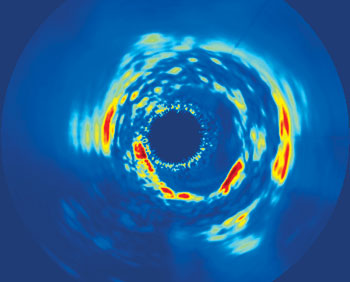 |
A breakthrough in computational medicine is helping one professor uncover the heart’s ticking “time-bomb.”
Ioannis Kakadiaris, director of the Computational Biomedicine Laboratory, is collaborating with cardiologists from the Association for Eradication of Heart Attack in this research effort. With cardiovascular disease accounting for twice as many deaths as all cancers in the United States combined, the professor of computer science is providing clinicians with a new assessment tool to alert physicians to a heart attack risk.
This “time-bomb,” also known as “vulnerable plaque,” is in the hearts of unaware, healthy-looking people or “vulnerable patients” who bear a more than 10 percent risk of having a heart attack in the next twelve months. Kakadiaris received a three-year, $566,350 grant from the National Science Foundation’s Division of Information and Intelligent Systems to support his efforts to defuse these time bombs.
|
This imaging technology will give doctors the ability, for the first time, to detect “inflamed plaque,” representing regions of blood vessels prone to future rupture and sudden blockage.
A cross-sectional view of the interior of a human coronary artery, as captured by an intravascular ultrasound and UH’s Computational Biomedicine Lab ACES software. The darkest red spots indicate calcified deposits of advanced atherosclerosis, a symptom of coronary artery disease. |
|
UH & ExxonMobil to train future African energy execs
Raquel Castro strolled across the stage this spring with something she had only dreamed of—a magna cum laude business degree from a leading American university. Castro enrolled at UH through a unique partnership between the university and ExxonMobil—the energy giant is working to supply home-grown professional talent for its operations in Africa. ExxonMobil’s Africa Group Upstream Regional Controller’s scholarship program assists promising students from African countries with tuition expenses at UH. Once they graduate, they’re placed in positions in one of ExxonMobil’s Africa-based affiliates. With a UH degree in hand, Castro returned home this summer and is now an accountant for ExxonMobil affiliate, Esso Angola. |
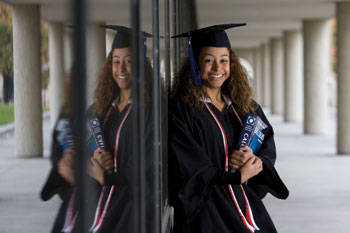 |
|
Nation’s First global energy EMBA launches at home and in Beijing
|
Some people thought the global energy workforce was running on empty, but UH is helping companies hire and retain qualified professionals. UH is ahead of the curve thanks to the C. T. Bauer College of Business, which is home to the nation’s first executive master of business degree in global energy management (GEMBA). Aimed at energy professionals, this program offers courses taught by industry veterans. Students graduate not only with a degree, but also with added experience and wisdom to meet the challenges of the ever-changing realm of global energy. UH has taken this concept abroad, and now, students in Beijing, China, also can receive a GEMBA. |
|
MBA student project saves $1 million for client
Six students … $1 million in savings. A great deal, but not that uncommon. Corporations throughout the area regularly seek fresh insight from students at the C. T. Bauer College of Business. It’s a winning solution—students gain real-world experience and their clients get Bauer’s brand of high-energy business know-how. This year, O’Rourke Petroleum, a large regional specialty fuels and lubricants distributor, hired six MBA students from the Business Consulting Lab program to identify cost savings in their operations. The students went to work and came up with a solution that saved the company $1 million. |
Fuel cells bring cheap, clean energy
More energy, less pollution … all at a lower cost. In this era of rising energy prices, it might sound like a dream, but UH researchers are working to make it a reality.
The answer is solid oxide fuel cells, says Allan Jacobson, Texas Center for Superconductivity at the University of Houston director, Robert A. Welch Chair in Science, and professor of chemistry. Fuel cells are limited to small scale and special applications, such as on the space shuttle; however, Jacobson is working to bring the technology closer to home. The challenge is the high temperatures required for efficient fuel cell reactions—the process requires exotic and expensive materials. Jacobson’s team is developing a process with new, cheaper materials that allow fuel cell reactions to occur at a lower temperature.
Initial applications will begin in niche markets, such as the trucking industry. A likely benefit of Jacobson’s research includes diesel-powered trucks using fuel cell power units to maintain air conditioning and refrigeration when the vehicles are stationary. This would save fuel and eliminate emissions when big-rig drivers utilize rest stops. |
Engineer brings "dead" wells back to life
Most oil wells yield less than half of the deposited oil in the traditional production method—the rest is left behind. In Texas alone, 120 billion barrels of oil are stranded in “dead” wells—enough to keep the entire world running for four years. Some of this oil has been passed up because it simply sticks to the rocks.
Not anymore, says Kishore Mohanty, professor of chemical engineering. He has developed a technology that could recover 15 billion barrels of stranded oil in Texas alone and billions more worldwide. Fifteen billion barrels of oil is enough to feed American oil consumption for three years. Mohanty’s technology is cheap, effective, and works like a clothing detergent for oil-soaked rocks. He uses low concentrations of chemicals called surfactants that essentially wash oil off the rock so that it can be collected. The estimated cost of this process is about 50 cents to $1 per barrel to recover oil from an otherwise dead well.
His efforts earned endorsement and financial support from the U.S. Department of Energy, as well as partnerships with energy giants such as ExxonMobil, BP, Chevron Corporation, and Schlumberger.
Professor Kishore Mohanty is shown with oil recovered from a fractured rock by the diluted surfactant treatment. The oil is collected at the top of the glass cell. |
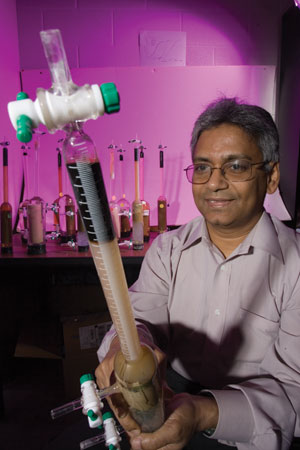
|
Scientist uses submarine technology for accurate oil maps
The greatest risk in oil exploration is not knowing what lies beneath. John Castagna may have solved that problem to some extent. Using a sophisticated version of the echolocation used in submarines, ships, and radar systems, he developed algorithms that translate seismic waves that not only detect fluids, but also can differentiate between porous rock filled with water, oil, or gas. The result is a cost-effective image of an underground reservoir that gives engineers a precise road map of where to drill, how far to drill, and how much of the resources can be extracted—all reducing exploration costs. Castagna, Margaret S. and Robert E. Sheriff Endowed Chair in Applied Seismology, earned the Reginald Fessenden Award from the Society of Geophysicists for his research. |
UH teams with federal, corporate partners for new superconductor wire
The research may not be in lights, but it’s going to make lights more efficient. Scientists at the Texas Center for Superconductivity at the University of Houston are partnering
with industry and national laboratories to develop a second-generation wire composed of superconducting materials discovered and developed at the center. Applications range from energy efficient, environmentally friendly transmission cables, transformers, and motors to fault current limiters. The center’s partners on this project range from Texas utilities to the U.S. Department of Energy to national and international energy and manufacturing companies.
The Texas Center for Superconductivity at the University of Houston is fueling cutting-edge research that may lead to the new power grid of the future with applications for increased efficiency and energy savings. |
Tiny radios could signal cheaper oil prices
Radios the size of a single grain of sand could make a huge difference in the price of oil.
Each year, oil companies lose hundreds of millions of dollars in failed drilling attempts or by drilling wells that yield less oil than expected—a cost absorbed by the consumer.
Working like an army of underground engineers, Professor of Electrical and Computer Engineering Richard Liu’s radios, when fully developed, will give a bird’s-eye view of a process known as well logging—recording of a well’s underground properties to find oil-rich zones. The tiny technology is suited to withstand the extreme conditions of the job that hinder traditional well logging technologies—the radios can withstand temperatures of 300 degrees or higher and pressures in excess of 20,000 pounds. As the radios are circulated, they transmit information to the surface for analysis, allowing for faster, more accurate drilling—potentially saving millions of dollars on every well on which the technology is used. |
Keyfitz chalks another first with Farfel Award
Barbara Keyfitz is no stranger to firsts. Last year, she was the first woman selected to direct one of the world’s most respected mathematics research institutions, Canada’s Fields Institute. This year, she was the first female scientist to receive the university’s highest faculty honor, the Esther Farfel Award. One of the world’s preeminent experts on nonlinear partial differential equations, the John and Rebecca Moores Professor of Mathematics received the Farfel award for her career merit and service to the university.
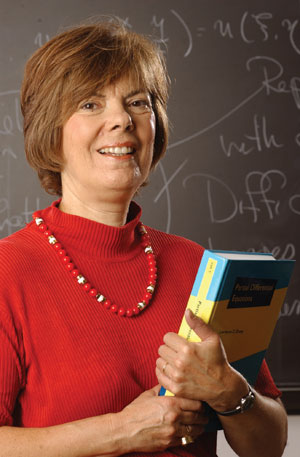
|
Psychologist receives $750Kto study anxiety disorder treatments
The National Institute of Mental Health (NIMH) has recognized a University of Houston faculty member as a researcher on the rise. Peter Norton, director of UH’s Anxiety Disorder Clinic and assistant professor of psychology, is the Department of Psychology’s first recipient of NIMH’s Mentored Research Scientist Development Award. This honor carries a $750,000 grant that will be applied toward a five-year study comparing methods of treating anxiety disorders. His research will focus on adapting cognitive behavior therapy to different types of anxiety disorders. The results of this study could help psychologists treat different anxiety disorders using a single, efficient treatment. |
Study checks equal opportunity in sports medicine
There’s a big difference between men’s and women’s professional sports in terms of pay—but does that difference extend to sports medicine? To find out, Joe Kotarba, professor of sociology, received a grant from the Southwest Center for Occupational and Environmental Health, a research institution supported by the National Institute for Occupational Safety and Health. The study will investigate the types of injuries sustained, the level of healthcare received, and the quality of care provided for women athletes. Kotarba also will examine how teams provide healthcare and how female athletes develop healthcare support groups among themselves. |
Professors garner top honors
UH professors have earned impressive accolades, placing them in the same company as past U.S. presidents, Pulitzer Prize winners, and the like. Roland Glowinski, Hugh Roy and Lillie Cranz Cullen Distinguished Professor of Mathematics and mechanical engineering professor, was elected a member of the French Academy of Sciences. Martin Golubitsky, Hugh Roy and Lillie Cranz Cullen Distinguished Professor of Mathematics, was elected to the American Academy of Arts and Sciences. Fazle Hussain, Hugh Roy and Lillie Cranz Cullen Distinguished Professor of Mechanical Engineering, was elected an officer of the National Academy of Engineering’s Mechanical Engineering Section.
Dan Luss, Cullen Engineering Endowed Professor, received the American Institute of Chemical Engineers’ 2005 Founders Award for Outstanding Contributions to the Field of Chemical Engineering. Jerald W. Strickland, optometry professor and assistant vice president for international studies and programs, received the American Optometric Association’s Distinguished Service Award. |
Houston’s violent crime scrutinized in new study
UH has recruited an expert to study Houston crime and the Latino community. Ramiro Martinez, criminologist and visiting scholar at UH’s Center for Mexican American Studies (CMAS), is looking to build on Houston crime studies completed in the 1970s. His research, part of the larger CMAS effort to generate research about the Latino community, will focus on Houston Latinos’ involvement in violent crimes from the mid-1980s to now. Working closely with law enforcement, he hopes to discover how involvement in violent crime varies by race, age, and gender as well as by immigrant and nonimmigrant status. |
Architect aims to shed light on prison design, construction
No one wants to go to prison … unless they’re Thomas Colbert. The associate professor of architecture is visiting Texas Department of Criminal Justice facilities in Houston and Huntsville to better understand prison architecture. Outside of what the public has seen in movies and on television, few understand how prisons are constructed. Colbert’s research is aimed at enlightening fellow architects to the function and design of prisons. The study will highlight the architectural differences between prison facilities, the architectural interpretation of their buildings, and the role of the designer in shaping them. |
DailyReview allows special ed teachers to get back to basics
Special education teachers can go back to what they do best—teaching. Thanks to the DailyReview, most time-consuming administrative tasks such as charting a student’s daily academic progress, goals, and grades are now automated through an interactive software system. The College of Education ’s Stewart Pisecco, associate professor of educational psychology, and Robert McPherson, professor of educational psychology, developed the tool through their company, Psychological Software Solutions. Already in use district wide in Houston and Dallas ISDs, the system is helping student behavioral and educational progress and is saving the districts thousands of dollars in lost man hours. A version for a |
Former NSF director to lead Center for Public Policy
Jim Granato, former political science program director for the National Science Foundation, will lead the UH Center for Public Policy, bringing lessons learned at the federal level to Houston. He plans for a collaborative, unified model of public policy research that breaks down the traditional walls between the social sciences. The combined disciplines will unify mathematical models, case studies, and applied statistical analysis. The results: more accurate predictive power and a tighter relationship between theory and real-world tests—allowing lawmakers the ability to make better-informed public policy decisions. The interdisciplinary research method also can be used to study quality-of-life issues ranging from air quality to taxation to trade agreements and more. The Center for Public Policy has served as Houston’s premier source of impartial research in politics, economics, and education since 1981. |
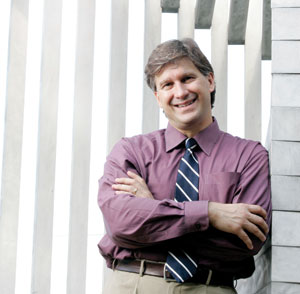
|
|
|
